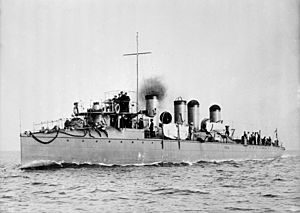Japanese destroyer Kasumi (1902) facts for kids
 |
|
Quick facts for kids History |
|
|---|---|
| Name | Kasumi |
| Namesake | 霞 ("Mist") |
| Ordered | 1900 |
| Builder | Yarrow & Company, Cubitt Town, London, England |
| Yard number | Destroyer No. 14 |
| Laid down | 1 February 1901 |
| Launched | 23 January 1902 |
| Completed | 14 February 1902 |
| Commissioned | 14 February 1902 |
| Reclassified | Third-class destroyer 28 August 1912 |
| Stricken | 1 April 1913 |
| Renamed |
|
| Reclassified | "Miscellaneous ship" (cargo ship, minesweeper, target ship) 23 August 1913 |
| Fate | Scrapped |
| General characteristics | |
| Type | Akatsuki-class destroyer |
| Displacement |
|
| Length |
|
| Beam | 6.28 m (20.6 ft) |
| Draught | 1.73 m (5.7 ft) |
| Propulsion | 2-shaft reciprocating, 4 Yarrow boilers, 6,000 ihp (4,500 kW) |
| Speed | 30 knots (56 km/h) |
| Complement | 62 |
| Armament |
|
| Service record | |
| Operations: |
|
Kasumi (霞, "Mist") was one of two Akatsuki-class destroyers, built for the Imperial Japanese Navy in the early 1900s. A destroyer is a fast, agile warship designed to protect larger ships and attack enemy vessels. During the Russo-Japanese War (1904–1905), Kasumi took part in important battles like the Battle of Port Arthur and the Battle of Tsushima. She also participated in the Battle of Tsingtao in 1914 during World War I (1914–1918).
Contents
Building the Destroyer Kasumi
Kasumi was ordered as part of a naval plan in 1900. She was built by Yarrow & Company in London, England. Her construction began on 1 February 1901.
The ship was launched on 23 January 1902 and officially named Kasumi. She was completed and joined the Japanese Navy on 14 February 1902. Kasumi was a fast ship, able to reach speeds of 30 knots (about 55 kilometers per hour). She carried several guns and two torpedo tubes, which fired underwater missiles. Her crew included 62 sailors.
Kasumi in the Russo-Japanese War
Kasumi left England on 10 March 1902 and arrived in Japan on 15 June 1902. When the Russo-Japanese War began on 8 February 1904, Kasumi was part of the 1st Destroyer Division.
Attack on Port Arthur
The war started with a surprise attack by Japan on Russian warships at Port Arthur, China. On the evening of 8 February 1904, Japanese destroyers, including Kasumi, launched a torpedo attack. Kasumi fired one of her torpedoes, which hit the Russian cruiser Pallada.
The Reshitel‘nyi Incident
After the Battle of the Yellow Sea on 10 August 1904, a Russian destroyer named Reshitel‘nyi tried to escape to Chefoo, China. China was a neutral country, so Reshitel‘nyi planned to disarm and stay there.
However, the Japanese destroyers Kasumi and Asashio entered the port on 12 August. The Japanese tried to capture Reshitel‘nyi, saying that the battle was still ongoing. After a struggle, the Japanese took control of Reshitel‘nyi and towed her away. This event caused some disagreement because it happened in a neutral country's waters.
Battle of Tsushima
On 10 May 1905, Kasumi joined the 3rd Destroyer Division. She then took part in the major Battle of Tsushima on 27–28 May 1905. This was a decisive naval battle where the Japanese Navy defeated the Russian fleet.
Later Service and Fate
Kasumi was removed from the official naval list on 1 April 1913. On 23 August 1913, she was reclassified as a "miscellaneous ship." This meant she could be used for different jobs, like carrying cargo or clearing mines from the sea. She was also renamed Kasumi Maru.
As Kasumi Maru, she participated in the Battle of Tsingtao after Japan joined World War I in August 1914. Later, she was used as a target ship for training. On 1 July 1920, her name was changed back to Kasumi. Eventually, she was taken apart for scrap metal.
Images for kids
-
Illustration of the Japanese seizure of the Russian destroyer Reshitel‘nyi at Chefoo, China, from Le Petit Parisien, 28 August 1904.


